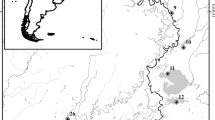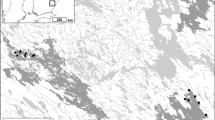Abstract
We explored the strength of connectedness among hierarchical system components associated with oxbow lakes in the alluvial valley of the Lower Mississippi River. Specifically, we examined the degree of canonical correlation between land use (agriculture and forests), lake morphometry (depth and size), nutrients (total nitrogen and total phosphorus), primary production (chlorophyll-a), and various fish assemblage descriptors. Watershed (p < 0.01) and riparian (p = 0.02) land use, and lake depth (p = 0.05) but not size (p = 0.28), were associated with nutrient concentrations. In turn, nutrients were associated with primary production (p < 0.01), and primary production was associated with sunfish (Centrarchidae) assemblages (p < 0.01) and fish biodiversity (p = 0.08), but not with those of other taxa and functional guilds. Multiple chemical and biological components of oxbow lake ecosystems are connected to landscape characteristics such as land use and lake depth. Therefore, a top-down hierarchical approach can be useful in develo** management and conservation plans for oxbow lakes in a region impacted by widespread landscape changes due to agriculture.



Similar content being viewed by others
References
Allan JD, Johnson LB (1997) Catchment-scale analysis of aquatic ecosystems. Freshw Biol 37:107–111
Anderson MJ, Robinson J (2003) Generalized discriminant analysis based on distances. Aust NZ J Stat 45:301–318
Anderson MJ, Willis TJ (2003) Canonical analysis of principal coordinates: a useful method of constrained ordination for ecology. Ecology 84:511–525
Anderson MJ, Gorley RN, Clarke KR (2008) PERMANOVA+ for PRIMER: guide to software and statistical methods. PRIMER-E, Plymouth, p 237
APHA (American Public Health Association) (1998) Standard methods for the examination of water and wastewater. 20th edn. APHA, Washington. p 1325
Baker JA, Killgore KJ, Kasul RL (1991) Aquatic habitats and fish communities in the lower Mississippi River. Rev Aquat Sci 3:313–356
Balon EK (1990) Epigenesis of an epigeneticist: the development of some alternative concepts on the early ontogeny and evolution of fishes. Guelph Ichthyol Rev 1:1–42
Branson BA, Moore GA (1962) The lateralis components of the acoustico-lateralis system in the sunfish family Centrarchidae. Copeia 1962:1–108
Cade BS, Terrell JW, Schroeder RL (1999) Estimating effects of limiting factors with regression quantiles. Ecology 80:311–323
Canfield DE Jr (1983) Prediction of chlorophyll a concentrations in Florida lakes: the importance of phosphorus and nitrogen. J Am Water Resour Assoc 19:255–262
Clarke KR, Gorley RN (2006) PRIMER V6: user manual/tutorial. PRIMER-E, Plymouth, p 192
Dembkowski DJ, Miranda LE (2011) Comparison of fish assemblages in two disjoined segments of an oxbow lake in relation to connectivity. Trans Am Fish Soc 140:1060–1069
Elser JJ, Marzolf ER, Goldman CR (1990) Phosphorus and nitrogen limitation of phytoplankton growth in the freshwaters of North America: a review and critique of experimental enrichments. Can J Fish Aquat Sci 47:1448–1477
Forsythe SW (1985) The protection of bottomland hardwood wetlands of the Lower Mississippi Valley. Trans N Am Wildl Nat Resour Conf 50:566–572
Frissell CA, Liss WJ, Warren CE, Hurley MD (1986) A hierarchical framework for stream habitat classification: viewing streams in a watershed context. Environ Manag 10:199–214
Frost PC, Kinsman LE, Johnston CA, Larson JH (2009) Watershed discharge modulates relationships between landscape components and nutrient ratios in stream seston. Ecology 90:1631–1640
Gao J (2009) Bathymetric map** by means of remote sensing: methods, accuracy and limitations. Prog Phys Geogr 33:103–116
Goldstein RM, Simon TP (1999) Toward a united definition of guild structure for feeding ecology of North American freshwater fishes. In: Simon TP (ed) Assessing the sustainability and biological integrity of water resources using fish communities. CRC Press, Boca Raton, pp 123–202
Hammer Ø, Harper DAT, Ryan PD (2001) PAST: Paleontological statistics software package for education and data analysis. Palaeontologia Electronica 4
Jones JR, Hoyer MV (1982) Sportfish harvest predicted by summer chlorophyll-α concentration in Midwestern lakes and reservoirs. Trans Am Fish Soc 111:176–179
Jørgensen SE, Xu FL, Costanza R (eds) (2005) Handbook of ecological indicators for assessment of ecosystem health. CRC Press, Boca Raton, p 448
Knowlton MF, Jones JR (1996) Nutrient addition experiments in a nitrogen-limited high plains reservoir where nitrogen-fixing algae seldom bloom. J Freshw Ecol 11:123–130
Kröger R, Cooper CM, Moore MT (2008) A preliminary hydrological investigation into an innovative controlled drainage strategy in surface drainage ditches: low-grade weirs. Agric Water Manag 95:678–684
Kröger R, Pierce SC, Littlejohn KA, Moore MT, Farris JL (2012) Decreasing nitrate-N loads to coastal ecosystems with innovative drainage management strategies in agricultural landscapes: an experimental approach. Agric Water Manag 103:162–166
Kröger R, Littlejohn KA, Pierce SC, Henderson J, Brandt J, Flora C, Poganski BH, Prevost JD (2013) Evidence towards sediment accumulation characteristics of slotted pipes as best management practices on agricultural landscapes. Ecol Eng 51:249–255
Magnuson JJ, Tonn WM, Banerjee A, Toivonen J, Sanchez O, Rask M (1998) Isolation vs. extinction in the assembly of fishes in small northern lakes. Ecology 79:2941–2956
McHenry JR, Cooper CM, Ritchie JC (1982) Sedimentation in Wolf Lake, lower Yazoo River basin, Mississippi. J Freshw Ecol 1:547–558
Mehner T, Diekmann M, Brämick U, Lemcke R (2005) Composition of fish communities in German lakes as related to lake morphology, trophic state, shore structure and human-use intensity. Freshw Biol 50:70–85
Miller RR (1959) Origin and affinities of the freshwater fish fauna of western North America. In: Hubbs CL (ed) Zoogeography. American Association for the Advancement of Science Publication 51. Arno Press, New York, pp 187–222
Miranda LE (2011) Depth as an organizer of fish assemblages in floodplain lakes. Aquat Sci 73:211–221
Miyazono S, Aycock JN, Miranda LE, Tietjen TE (2010) Assemblage patterns of fish functional groups relative to habitat connectivity and conditions in floodplain lakes. Ecol Freshw Fish 19:578–585
Niemi GJ, DeVore P, Detenbeck N, Taylor D, Lima A, Pastor J, Yount JD, Naiman RJ (1990) Overview of case studies on recovery of aquatic systems from disturbance. Environ Manag 14:571–587
Nõges T (2009) Relationships between morphometry, geographic location and water quality parameters of European lakes. Hydrobiologia 633:33–43
Nõges T, Järvet A, Kisand A, Laugaste R, Loigu E, Skakalski B, Nõges P (2007) Reaction of large and shallow lakes Peipsi and Vortsjaerv to the changes of nutrient loading. Hydrobiologia 584:253–264
Pridmore RD, Vant WN, Rutherford JC (1985) Chlorophyll-nutrient relationships in North Island lakes (New Zealand). Hydrobiologia 121:181–189
Rader RB, Richardson CJ (1992) The effects of nutrient enrichment on algae and macroinvertebrates in the Everglades: a review. Wetlands 12:121–135
Ritchie JC, Cooper CM, McHenry JR (1979) Recent accumulation of sediment in lakes in the Bear Creek watershed in the Mississippi Delta. Southeast Geol 20:173–180
Ross ST (2001) The inland fishes of Mississippi. University of Mississippi Press, Jackson, p 624
Scheffer M, van Nes EH (2007) Shallow lakes theory revisited: various alternative regimes driven by climate, nutrients, depth and lake size. Hydrobiologia 584:455–466
Schindler DW (1977) Evolution of phosphorus limitation in lakes. Science 195:260–262
Schindler DE, Scheuerell MD (2002) Habitat coupling in lake ecosystems. Oikos 98:177–189
Tejerina-Garro FL, Fortin R, Rodríguez MA (1998) Fish community structure in relation to environmental variation in floodplain lakes of the Araguaia River, Amazon Basin. Environ Biol Fishes 51:399–410
Townsend CR (1996) Concepts in river ecology: pattern and process in the catchment hierarchy. Arch Hydrobiol Suppl 113:3–21
Vadeboncoeur Y, Lodge DM, Carpenter SR (2001) Whole lake fertilization effects on distribution of primary production between benthic and pelagic habitats. Ecology 82:1065–1077
Ward JV (1998) Riverine landscapes: biodiversity patterns, disturbance regimes, and aquatic conservation. Biol Conserv 83:269–278
Welch HL, Green CT, Rebich RA, Barlow JRB, Hicks MB (2010) Unintended consequences of biofuels production: The effects of large-scale crop conversion on water quality and quantity. U.S. Department of the Interior, U. S. Geological Survey, Open-File Report 2010–1229
Wetzel RG (2001) Limnology: lake and river ecosystems, 3rd edn. Academic Press, San Diego, p 1006
Wiens JA (2002) Riverine landscapes: taking landscape ecology into the water. Freshw Biol 47:501–515
Wren DG, Davidson GR, Walker WG, Galicki SJ (2008) The evolution of an oxbow lake in the Mississippi alluvial floodplain. J Soil Water Conserv 63:129–135
Acknowledgments
Funding and support was provided by the Vicksburg District of the U.S. Army Corps of Engineers through K. J. Killgore, Mississippi State University, and the U.S. Geological Survey. We thank T. Alfermann, N. Aycock, D. Dembkowski, D. Goetz, and S. Miyazono for assistance with field work; L. Brooks for water quality analyses; and J. Murdock for a helpful review. The use of trade names or products does not constitute endorsement by the federal government.
Author information
Authors and Affiliations
Corresponding author
Rights and permissions
About this article
Cite this article
Miranda, L.E., Andrews, C.S. & Kröger, R. Connectedness of land use, nutrients, primary production, and fish assemblages in oxbow lakes. Aquat Sci 76, 41–50 (2014). https://doi.org/10.1007/s00027-013-0310-y
Received:
Accepted:
Published:
Issue Date:
DOI: https://doi.org/10.1007/s00027-013-0310-y




